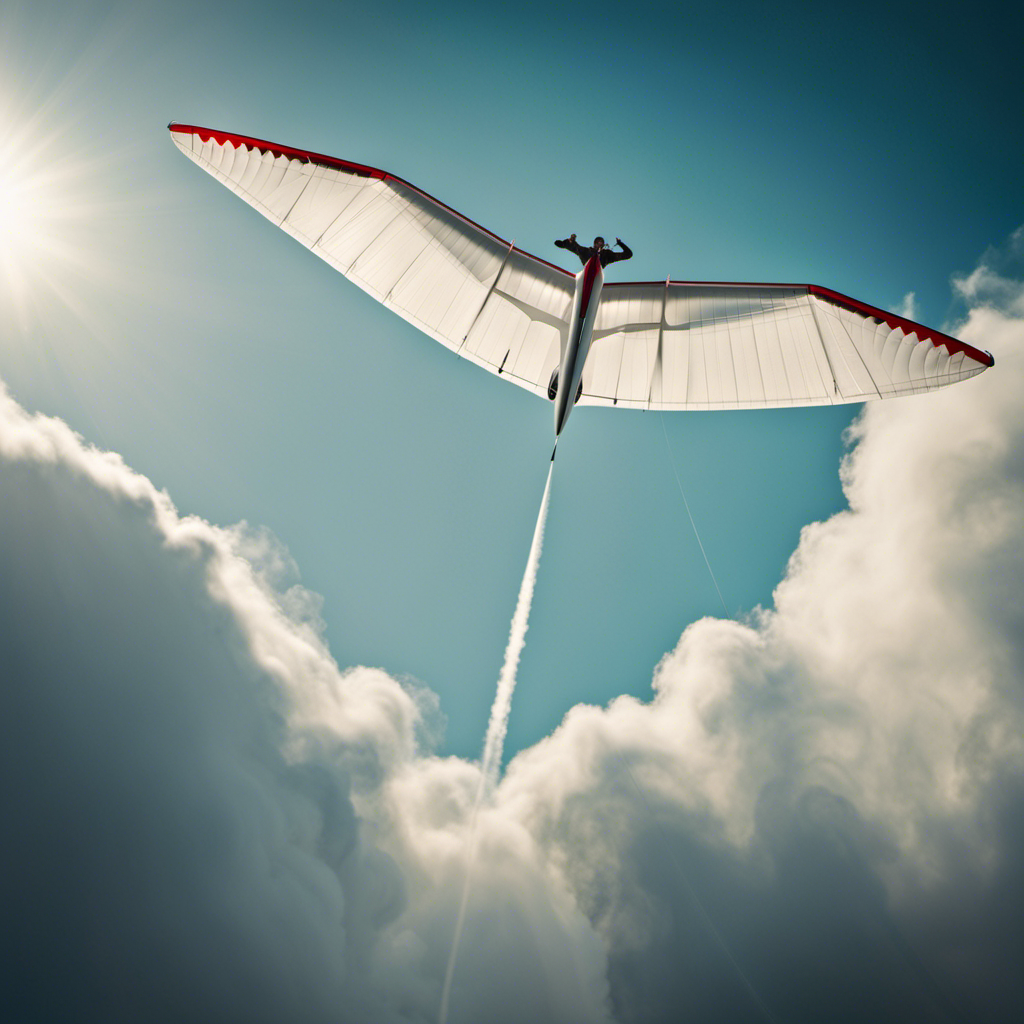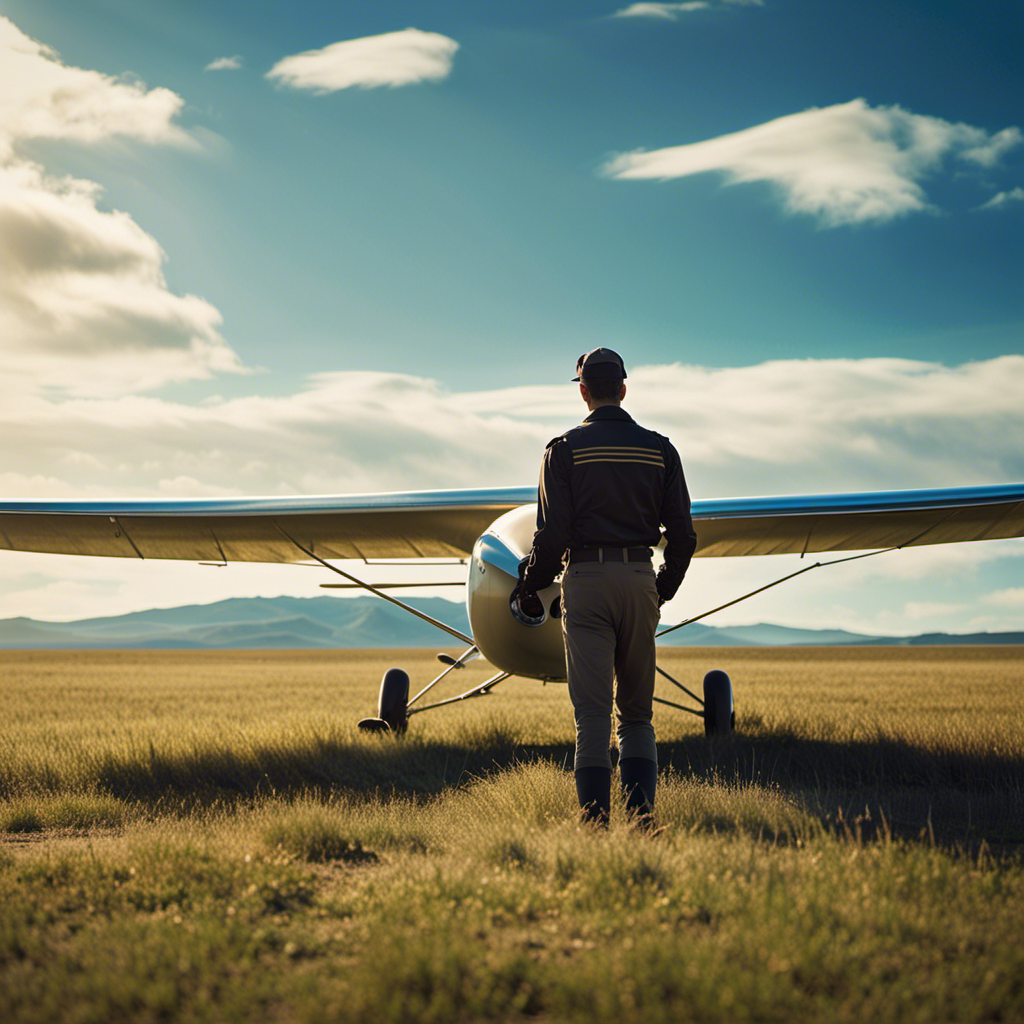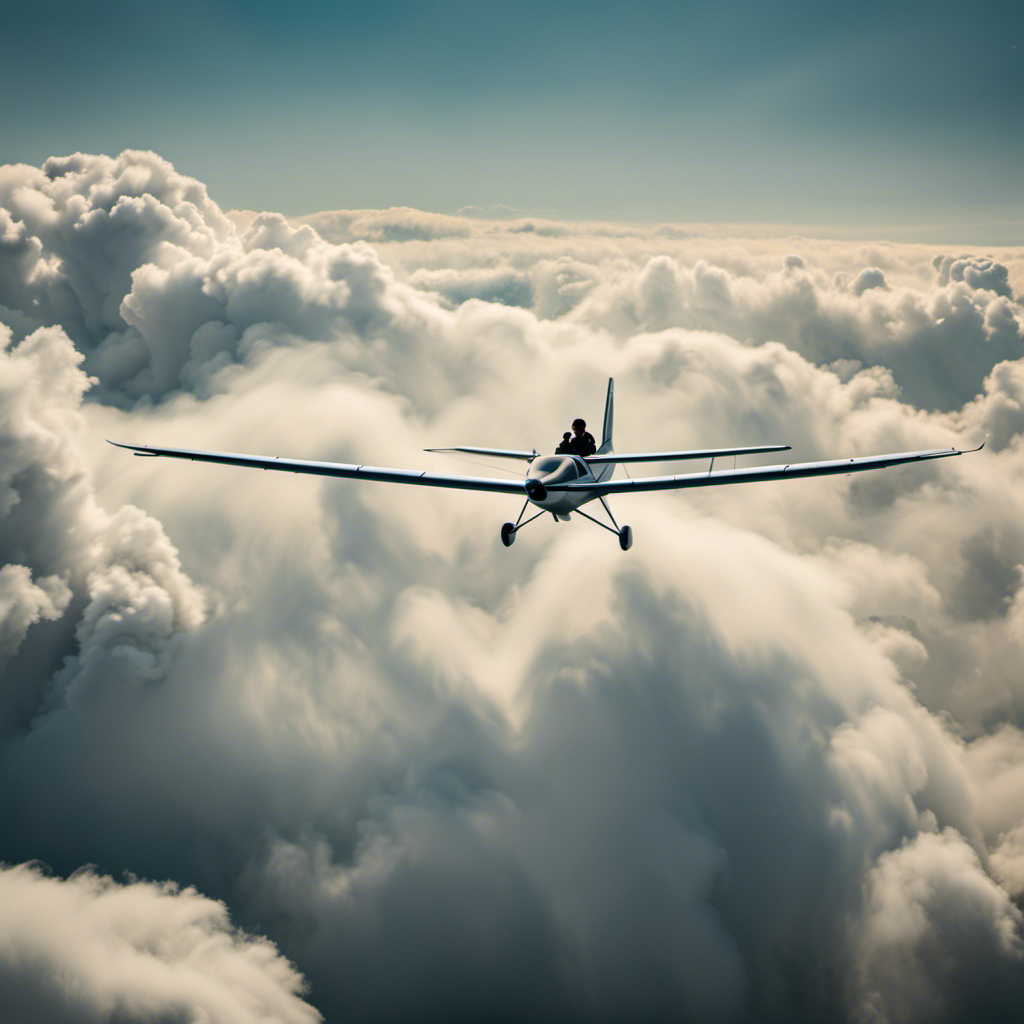Ascending into the sky using the bungee launch method for gliders is a thrilling way to take off. As a glider pilot myself, I can attest to the exhilaration and precision that this unique technique provides.
Using a bungee cord system, the glider is propelled into the air with incredible speed and efficiency.
In this article, I will guide you through the basics of glider flying and introduce you to the ins and outs of the glider bungee launch technique.
Get ready to soar to new heights with this innovative and exciting approach to glider aviation.
Key Takeaways
- Regularly inspect and maintain equipment to reduce the risk of failure or malfunction
- Undergo proper training and certification to ensure competence and adherence to safety procedures
- Use high-strength bungee cord and a release mechanism designed to withstand launch forces
- Choose launch sites with optimal wind patterns and runway length for successful and safe launches
The Basics of Glider Flying
If you’re new to glider flying, the basics can seem a bit overwhelming at first. But don’t worry, with some practice and understanding of the glider equipment and maneuvers, you’ll be soaring through the skies in no time.
When it comes to glider equipment, there are a few key components that you need to familiarize yourself with. Firstly, you have the glider itself, which is a lightweight aircraft without an engine. It relies on the air currents to stay aloft. You also have the control surfaces, such as ailerons, elevators, and rudders, which allow you to maneuver the glider. Additionally, there are instruments like altimeters, variometers, and airspeed indicators that provide important information during flight.
Now, let’s talk about glider maneuvers. These are the different movements and techniques you’ll need to learn to control the glider effectively. One of the most basic maneuvers is the bank turn, where you tilt the glider to one side to change direction. Another important maneuver is the stall recovery, which involves regaining lift after the glider has temporarily lost it. Lastly, you’ll need to master the art of landing, which requires precise control and timing to touch down smoothly.
Understanding these basics of glider flying will set you up for success as you progress in your flying journey. Now, let’s move on to the introduction to the glider bungee launch technique, where you’ll learn how to get your glider off the ground without an engine.
Introduction to the Glider Bungee Launch Technique
To get started, you’ll want to familiarize yourself with the basic principles of the glider bungee launch method. The glider bungee launch technique is a popular method used to launch gliders into the sky. It offers several benefits over other launch methods, such as aerotowing or winching.
One of the main benefits is cost-effectiveness. Glider bungee launch equipment is relatively inexpensive compared to other launch methods, making it accessible to a wider range of glider pilots. Additionally, the glider bungee launch method allows for a quicker turnaround time between launches, increasing the number of flights that can be made in a day.
The equipment used for glider bungee launch consists of a bungee cord attached to a stationary anchor point, and a release mechanism that connects the bungee cord to the glider. The bungee cord is stretched to its maximum potential energy and then released, propelling the glider into the air. This launch method relies on the stored energy in the bungee cord to provide the initial thrust needed to get the glider airborne.
Now that we have discussed the benefits and equipment involved in the glider bungee launch technique, let’s delve into how this method actually works.
How the Glider Bungee Launch Technique Works
Now, let’s explore how you can make the glider bungee launch method work for you.
The glider bungee launch mechanism is a fascinating process that propels a glider into the sky using the power of elasticity. The bungee launch process involves attaching one end of a high-tension bungee cord to a secure anchor point on the ground, while the other end is connected to the glider. As the glider is released, the tension in the bungee cord rapidly contracts, creating a powerful force that launches the glider forward and upward.
To ensure a successful launch, it is crucial to carefully calculate and adjust the tension in the bungee cord. This requires considering factors such as the weight and size of the glider, as well as wind conditions and desired altitude. Additionally, the glider pilot must have precise timing and coordination to release the glider at the optimal moment to maximize the launch energy.
The glider bungee launch technique offers several benefits. Firstly, it provides a cost-effective alternative to other launch methods, such as aerotowing or winch launching. Secondly, it allows glider pilots to launch from remote or unprepared fields where traditional launch methods may not be feasible. Lastly, the bungee launch technique offers an exhilarating and dynamic launch experience, adding an extra level of excitement to glider flying.
Benefits of the Glider Bungee Launch Technique
The glider bungee launch method offers a cost-effective and exciting way for pilots to take off. This technique has several advantages over traditional methods of launching gliders.
Firstly, it is highly effective in getting the glider to the desired altitude quickly and efficiently. The bungee launch system utilizes a powerful elastic cord that is stretched to its maximum length and then released, propelling the glider into the air. This method ensures a rapid ascent, allowing pilots to reach optimal soaring conditions faster.
Another advantage of the glider bungee launch technique is its cost-effectiveness. Compared to other launch methods such as aerotowing or winching, the bungee launch system requires fewer resources and equipment. This translates into lower operational costs for glider pilots, making the sport more accessible to enthusiasts with limited budgets.
Furthermore, the bungee launch method offers a thrilling experience for pilots. The sudden release of tension from the bungee cord provides an exhilarating acceleration, adding an extra element of excitement to the takeoff process. This adrenaline rush enhances the overall enjoyment of gliding, making it a preferred choice for many pilots.
While the glider bungee launch technique has its advantages, it is essential to follow certain safety measures and precautions. These measures include proper inspection and maintenance of the bungee cord, ensuring it is in good condition and free from any signs of wear or damage. Additionally, pilots must receive thorough training on the correct procedure for launching using the bungee system to minimize the risk of accidents or mishaps.
Safety Measures and Precautions
Make sure you thoroughly inspect and maintain the bungee cord to ensure it is in good condition and free from any signs of wear or damage. A proper inspection is vital to ensure the safety of both the glider pilot and ground crew during the glider bungee launch. Regular maintenance and checks should be performed to identify any potential issues that may compromise the integrity of the bungee cord. This includes checking for frayed or worn sections, loose or damaged connectors, and any signs of stress or strain.
To emphasize the importance of equipment maintenance, let’s take a look at the following table:
| Equipment | Maintenance Required | Importance |
|---|---|---|
| Bungee cord | Regular inspection and replacement if necessary | Ensures safe launch and landing |
| Connectors | Tightening and checking for damage | Prevents detachment during launch |
| Ground anchor | Regular inspection and maintenance | Provides stability during launch |
By following these maintenance procedures, the risk of equipment failure or malfunction can be significantly reduced. However, it is important to be prepared for emergencies. Pilots and ground crew should be familiar with emergency procedures in case something goes wrong during the launch. This includes knowing how to quickly disconnect the bungee cord and safely land the glider in the event of an emergency.
Transitioning into the next section, it is essential for glider pilots and ground crew to undergo proper training and certification for glider bungee launch.
Training and Certification for Glider Bungee Launch
To ensure a safe and successful glider bungee launch, it is important that you undergo proper training and obtain the necessary certification. Training for glider bungee launch typically involves learning the fundamental principles of aerodynamics, understanding the mechanics of the bungee launch system, and practicing simulated launches under the guidance of experienced instructors. This training is crucial as it equips you with the necessary skills and knowledge to handle the unique challenges of glider bungee launch.
Additionally, obtaining the appropriate certification demonstrates your competence and adherence to safety procedures. Certification is usually granted by recognized governing bodies in the aviation industry and involves passing written and practical exams. The cost of training and certification for glider bungee launch can vary depending on the location and the organization providing the training. It is recommended to research and compare different training programs to find one that suits your needs and budget.
In terms of equipment, glider bungee launch requires specialized gear such as a high-strength bungee cord, a launch cart or dolly, and a release mechanism. These components are designed to withstand the forces exerted during the launch and ensure a smooth and controlled ascent into the air.
Tips for a Successful Glider Bungee Launch
After completing the necessary training and certification for glider bungee launch, it is time to dive into the exciting world of launching gliders into the sky. In this section, I will share some valuable tips for a successful glider bungee launch. Mastering these techniques and understanding the optimal launch conditions will greatly enhance your gliding experience.
To begin, let’s take a look at a table that outlines key glider bungee launch techniques and their benefits:
| Technique | Description |
|---|---|
| Consistent Tension | Maintaining a steady tension on the bungee line throughout the launch ensures a smooth and controlled ascent. |
| Proper Positioning | Position the glider at the optimal point on the runway to maximize the launch efficiency and minimize the risk of any launching mishaps. |
| Controlled Release | Gradually release the bungee line to provide a gradual acceleration, allowing the glider to smoothly transition into the air. |
Common Mistakes and How to Avoid Them
One of the most common mistakes to avoid during a glider bungee launch is improper positioning on the runway. To ensure a successful launch, it is crucial to position the glider correctly to maximize the efficiency of the bungee launch system.
When positioning the glider, I make sure that it is aligned with the bungee cord and pointed directly into the wind. This allows for a smooth takeoff and minimizes any potential complications.
Another mistake to avoid is not properly securing the glider to the bungee launch system. I always double-check the connections and ensure that everything is tightly fastened before initiating the launch.
Additionally, it is important to maintain constant communication with the launch team to troubleshoot any potential errors. By keeping an open line of communication, we can quickly address any issues that may arise and resolve them efficiently.
Avoiding these errors and utilizing troubleshooting techniques will greatly increase the chances of a successful glider bungee launch.
Transitioning into the subsequent section about exploring different glider bungee launch sites, it is important to note that the success of a launch also depends on the chosen launch site.
Exploring Different Glider Bungee Launch Sites
When exploring different glider bungee launch sites, it’s essential to consider factors like wind direction and available runway length. Choosing the right location can greatly impact the success and safety of your glider bungee launch. Here are three key considerations to keep in mind:
-
Wind Patterns: Evaluate the prevailing wind direction at the launch site. Ideally, you want a consistent and steady wind that aligns with the runway. This will provide the necessary lift and ensure a smooth takeoff. Avoid locations with unpredictable or gusty winds, as they can make the launch unstable and potentially dangerous.
-
Runway Length: Assess the available runway length at the launch site. The longer the runway, the more time you’ll have to build up speed and generate lift before the bungee cord reaches its maximum extension. Longer runways also allow for a safer and more controlled landing, giving you more room to decelerate.
-
Accessibility: Consider the accessibility of the launch site. Are there any obstacles, such as trees or power lines, that could interfere with the launch or landing? Additionally, check if there are any restrictions or permits required to use the site. Some unique glider bungee launch locations may have specific regulations that need to be followed.
Taking Your Glider Flying Experience to New Heights with the Bungee Launch Technique
To elevate your glider flying experience, you’ll be amazed at the heights you can reach using the bungee launch method. This technique allows you to maximize your altitude and soar through the sky like never before. However, to achieve these heights, it is essential to have the right equipment.
The bungee launch method requires a few key pieces of equipment. First, you’ll need a strong and sturdy bungee cord. This cord is attached to the glider and provides the necessary force for launching. It is important to ensure that the bungee cord is in good condition and properly secured to avoid any accidents during launch.
In addition to the bungee cord, you’ll also need a launch ramp. This ramp provides the slope necessary for a successful launch. It should be constructed with durable materials and positioned in a location that offers a clear and unobstructed path for the glider to take off.
To maximize your altitude using the bungee launch method, it is crucial to have a glider that is designed for high-performance flying. The glider should have a sleek and aerodynamic design, allowing it to cut through the air with minimal resistance. It should also be lightweight and have a strong structure to withstand the forces exerted during launch.
Frequently Asked Questions
What is the maximum weight limit for the glider bungee launch technique?
The maximum weight limit for the glider bungee launch technique varies depending on the type of glider. Different glider types have different weight limits, ensuring safe and efficient launches for each aircraft.
Can the glider bungee launch technique be used with any type of glider?
The glider bungee launch technique can be used with various types of gliders. However, it is important to consider the pros and cons, as well as the necessary safety precautions for a successful launch.
Are there any age restrictions for participating in glider bungee launches?
Age restrictions for glider bungee launches are in place to ensure safety. Participants must be at least 18 years old and physically fit. Safety measures include thorough training, equipment checks, and supervision by experienced professionals.
How long does it typically take to set up the bungee launch equipment?
Setting up bungee launch equipment typically takes around 30 minutes. Key components include the bungee cord, launch pulley system, and anchor points. Safety measures for glider bungee launches include following protocols and meeting training requirements.
Is the glider bungee launch technique suitable for beginners or is it more advanced?
The glider bungee launch technique is more suitable for advanced pilots due to safety considerations. However, with proper training and guidance, beginners can master this technique. Here are some tips and tricks to help you become proficient.
Conclusion
In conclusion, the glider bungee launch technique is a thrilling and efficient way to take your glider flying experience to new heights. By using the power of a bungee cord, you can launch your glider into the sky with precision and speed.
This technique offers numerous benefits, including increased altitude and reduced reliance on external power sources. However, it is important to follow safety measures and avoid common mistakes to ensure a successful launch.
So why wait? Take to the skies and experience the exhilaration of the glider bungee launch technique today!









